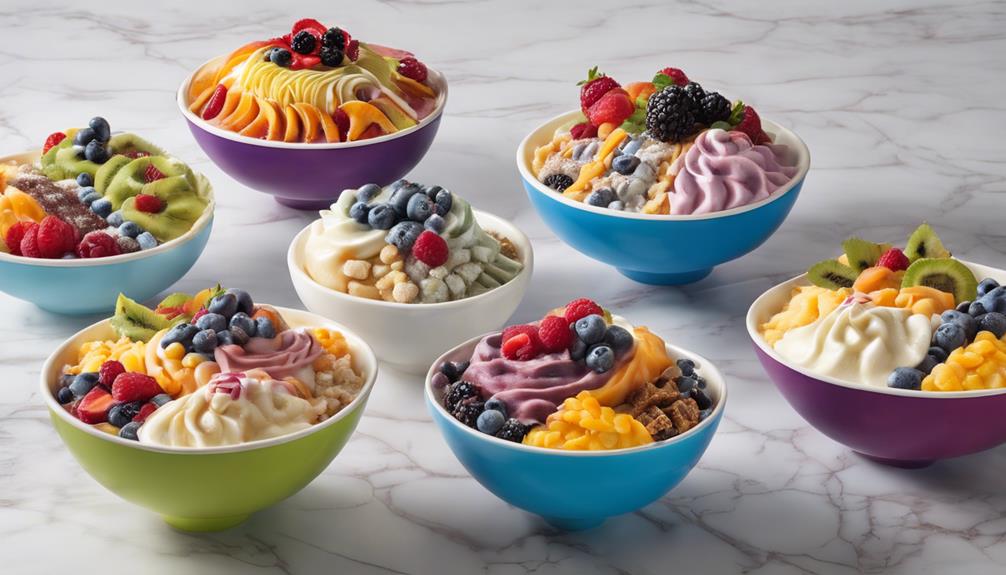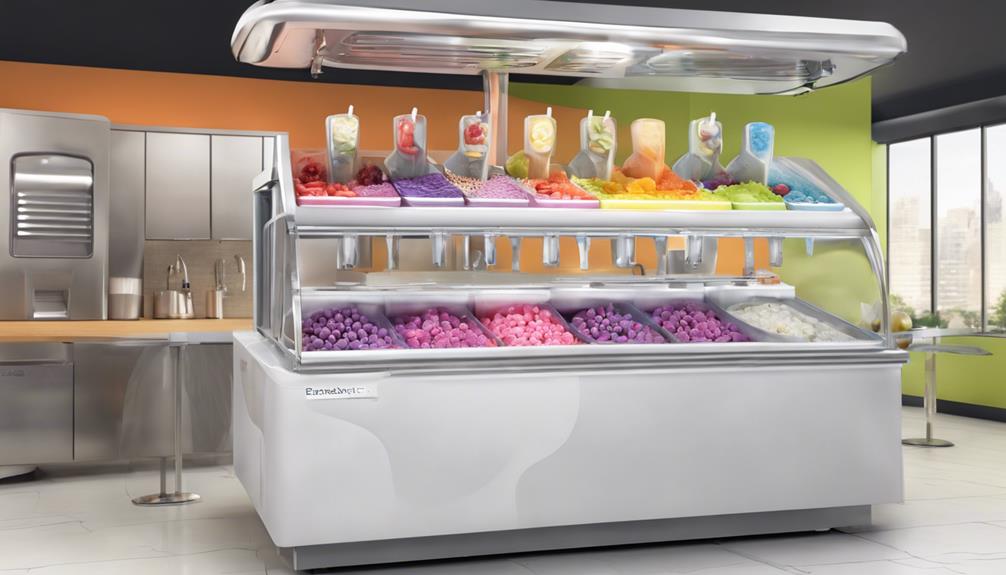Imagine walking into a frozen yogurt shop in the 1980s, where the air buzzes with a mix of health-conscious optimism and the tantalizing aroma of innovative flavors. You’d notice how frozen yogurt wasn’t just another dessert; it was a symbol of a cultural shift towards healthier living. Brands vied for your attention with exotic flavors like mango and green tea, while marketing campaigns promised a guilt-free indulgence. But what exactly drove this frozen treat’s meteoric rise during that decade? And how did it manage to become a global phenomenon? Let’s explore further.
Key Takeaways
- Frozen yogurt’s popularity surged in the 1980s due to health-conscious consumers seeking low-fat dessert alternatives.
- Sales of frozen yogurt reached $25 million in 1986, with shops expanding globally.
- Flavor innovations included exotic choices like mango and gourmet options like cappuccino.
- Marketing strategies focused on health benefits, celebrity endorsements, and visual appeal.
- TCBY and Yogen Fruz became dominant brands, with Yogen Fruz expanding to 1,300 locations by 2012.
Rise of Frozen Yogurt
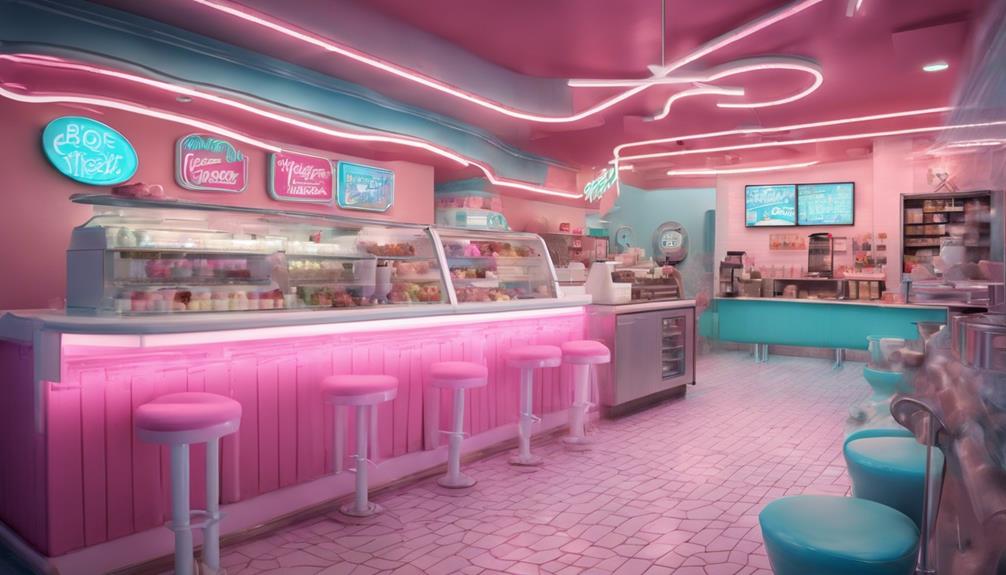
Frozen yogurt surged in popularity during the 1980s as manufacturers innovated with new flavors and textures to captivate health-conscious consumers. You’d find that the health craze of the decade played a big role in this rise. People were looking for alternatives to high-fat, high-calorie desserts, and frozen yogurt fit the bill perfectly. It wasn’t just about plain vanilla or chocolate anymore; companies started introducing a variety of enticing flavors that made frozen yogurt a trendy option.
In 1986, sales of frozen yogurt peaked at an impressive $25 million, reflecting its growing appeal. The dessert quickly expanded beyond just grocery store shelves. Frozen yogurt shops began popping up in malls and neighborhoods, making it more accessible than ever. This expansion wasn’t just limited to the United States; brands like Red Mango, which would later become a significant player, started laying the groundwork for their future success.
Popular Brands
TCBY, founded in 1981, quickly became a household name and the world’s largest frozen yogurt chain, boasting 3,000 locations across 70 countries by the year 2000. But TCBY wasn’t the only star in the frozen yogurt sky.
- Everything Yogurt: Founded in 1976, this chain paved the way for many others. Eventually, it merged with Bananas Smoothies and Frozen Yogurt, maintaining a presence across the country.
- I Can’t Believe It’s Yogurt: Established in 1977, this chain saw significant growth before being acquired by Yogen Fruz in 1996. This acquisition boosted Yogen Fruz’s outlets from 1,002 to 2,509, making it a major player in the market.
- Yogen Fruz: Founded in 1986, this brand quickly expanded and had 1,300 locations globally by 2012. Yogen Fruz acquired several frozen yogurt chains, including Golden Swirl in 1997, strengthening its market position.
Health Benefits
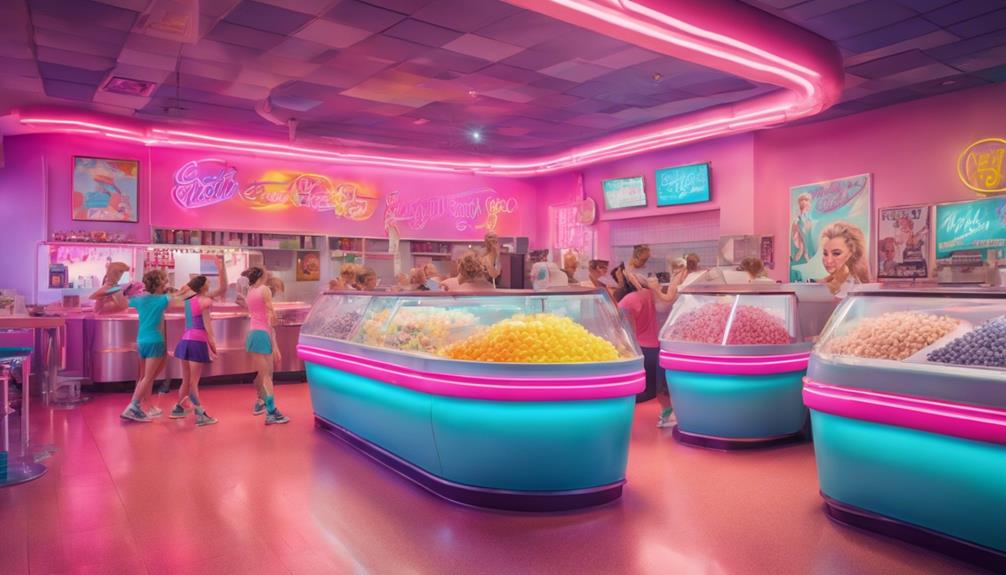
As the popularity of frozen yogurt brands soared during the 1980s, consumers were particularly drawn to the perceived health benefits of this tasty treat. During this era, health consciousness was on the rise, with more people seeking lighter dessert options to fit their active lifestyles. Frozen yogurt quickly became a favored choice due to its lower sugar, fat, and carbohydrate content compared to traditional ice cream.
In the 1980s, many individuals were also looking for dessert options that accommodated lactose allergies. Frozen yogurt, being a suitable alternative, widened its appeal among those who had to avoid lactose but still craved something sweet and satisfying. This versatility helped frozen yogurt stand out in a crowded dessert market.
Moreover, the lower fat and calorie content of frozen yogurt contributed to its image as a guilt-free indulgence. People could enjoy a delicious dessert without the same concerns about weight gain or unhealthy eating habits. As the health craze of the 1980s continued to grow, frozen yogurt’s reputation as a healthier, yet equally enjoyable, alternative to ice cream solidified its place in the diets of many health-conscious consumers.
Flavor Innovations
During the 1980s, the frozen yogurt industry saw a burst of creativity as manufacturers introduced a plethora of new and enticing flavors to captivate consumers. This decade was marked by flavor innovations that transformed the dessert landscape. Brands began experimenting with unique and appealing combinations to stand out in the competitive market.
Manufacturers capitalized on the health craze sweeping the nation by offering flavors that were not only delicious but also healthier alternatives to traditional ice cream. This led to a surge in experimentation and a wider variety of options for frozen yogurt enthusiasts. The era’s flavor innovations can be highlighted by several key trends:
- Exotic Flavors: Introducing flavors like mango, passion fruit, and green tea brought an international flair to the market.
- Gourmet Options: Flavors such as cappuccino, tiramisu, and cheesecake catered to more sophisticated palates.
- Fruit Combinations: Mixing berries, tropical fruits, and citrus provided invigorating alternatives.
- Health-Conscious Choices: Incorporating flavors like honey, granola, and low-sugar options appealed to those mindful of their diet.
These innovations not only expanded the flavor spectrum but also played an essential role in making frozen yogurt a popular, trendy choice during the 1980s.
Marketing Strategies
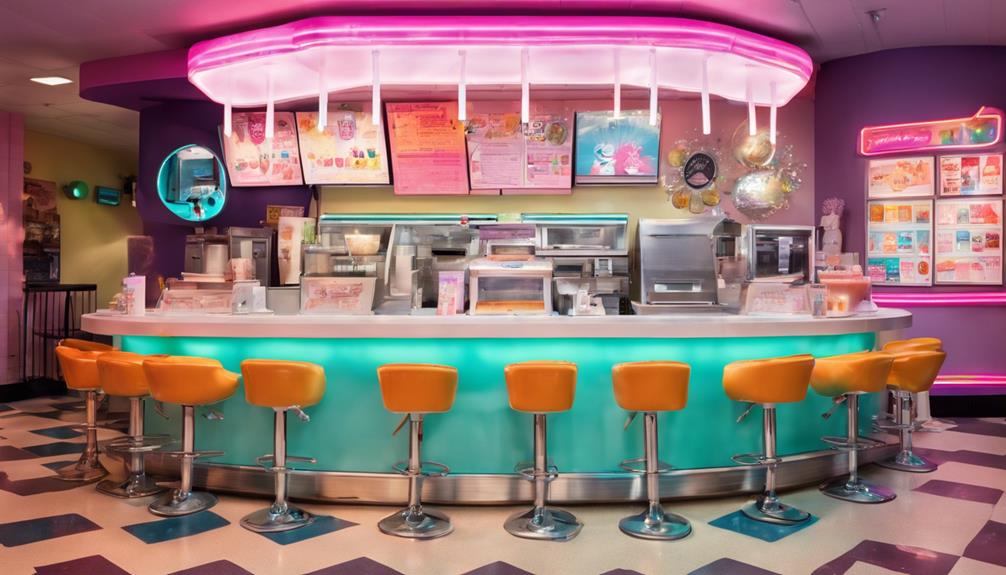
In the 1980s, you’d notice frozen yogurt brands leveraging celebrity endorsements to boost their appeal, with stars highlighting its healthier profile compared to ice cream. As the health craze took off, marketers targeted health-conscious consumers by emphasizing low-fat content and probiotic benefits. Innovative advertising techniques, from catchy jingles to vibrant TV commercials, helped solidify frozen yogurt’s place in popular culture and drive its market success.
Celebrity Endorsements Impact
The 1980s saw a dynamic shift in marketing strategies for frozen yogurt, with celebrity endorsements from icons like Leonardo DiCaprio, Paris Hilton, and Lindsay Lohan playing a pivotal role in making it the dessert of choice for a trend-conscious public. As you look back, you’ll see how these stars were instrumental in elevating the profile of frozen yogurt chains such as TCBY and I Can’t Believe It’s Yogurt. Their influence helped not only in increasing visibility but also in establishing frozen yogurt as a fashionable and desirable treat.
Celebrity endorsements became a cornerstone of marketing strategies, contributing significantly to the industry’s growth. Here’s how:
- Increased Visibility: Leveraging the star power of celebrities brought frozen yogurt into the limelight.
- Brand Association: Associating with trendy, influential figures made frozen yogurt synonymous with a fashionable lifestyle.
- Consumer Appeal: These endorsements drew a wider consumer base, making frozen yogurt a popular choice among various demographics.
- Industry Expansion: Partnerships with celebrities facilitated the rapid expansion of frozen yogurt chains, transforming them into household names.
In this era, the strategic use of celebrity endorsements truly helped to cement frozen yogurt’s status as a must-have treat for the style-savvy consumer.
Targeting Health Conscious Consumers
Embracing the health craze of the 1980s, frozen yogurt brands strategically marketed their products by emphasizing their lower fat and calorie content compared to traditional ice cream, making them a desirable choice for health-conscious consumers. You’d see advertisements highlighting the health benefits of frozen yogurt, which appealed to those looking for healthier dessert options. The tart flavor and lower calorie content were prominently featured to attract customers keen on nutritious treats.
Throughout the decade, manufacturers and frozen yogurt shops capitalized on the growing trend towards healthier eating habits. By the mid-1980s, these marketing strategies had greatly boosted the popularity of frozen yogurt. People were increasingly aware of their dietary choices, and frozen yogurt fit perfectly into this new health-conscious mindset.
Here’s a comparison detailing the nutritional differences:
| Attribute | Frozen Yogurt (1980s) | Traditional Ice Cream |
|---|---|---|
| Fat Content | Lower in fat | Higher in fat |
| Calorie Content | Lower calorie | Higher calorie |
| Flavor Profile | Tart | Sweet |
As the decade progressed, more consumers turned to frozen yogurt as a guilt-free indulgence, helping the industry flourish. This strategic focus on health-conscious marketing made frozen yogurt a staple in the diet of many during the 1980s.
Innovative Advertising Techniques
Frozen yogurt brands’ marketing strategies in the 1980s cleverly leveraged the decade’s health trends by highlighting their products’ low-fat and low-calorie content to attract health-conscious consumers. During this decade, companies recognized the growing demand for healthier dessert options and positioned yogurt as the perfect solution.
To captivate their audience, marketers emphasized the nutritional benefits of frozen yogurt compared to traditional ice cream. They crafted campaigns that made yogurt seem not just a healthier choice but a fashionable one too. Here’s how they did it:
- Health-Centric Messaging: Ads prominently highlighted the low-fat and low-calorie benefits, appealing directly to those mindful of their diet.
- Celebrity Endorsements: Brands enlisted fitness icons and celebrities to endorse their products, making yogurt seem trendy and aspirational.
- Visual Appeal: Commercials and print ads showcased vibrant, colorful imagery of fruits and wholesome ingredients, reinforcing the idea of a nutritious treat.
- Convenience & Accessibility: Marketers emphasized the ease of finding frozen yogurt, promoting its availability in various locations, from malls to standalone shops.
Cultural Impact
During the 1980s health craze, you couldn’t walk through a mall or neighborhood without noticing the surge of frozen yogurt shops, each boasting innovative flavors and textures that captivated the era’s health-conscious consumers. In New York, these shops became a symbol of the city’s dynamic food culture, offering a guilt-free alternative to traditional ice cream. The health-focused movement of the decade fueled this trend, aligning perfectly with the low-fat, high-flavor profile of frozen yogurt.
As the decade progressed, the frozen yogurt phenomenon spread rapidly across the country. By 1986, frozen yogurt sales had peaked at $25 million, reflecting its significant market presence. This surge was driven by the proliferation of shops in urban centers and suburban malls, where people were keen to try new, healthier dessert options.
The cultural impact was profound. Frozen yogurt became more than just a dessert; it was a social experience. Families and friends gathered at these shops, making it a staple of American lifestyle. The trend also spurred a wave of innovations in flavors and textures, keeping consumers curious and engaged. By the late 1980s, frozen yogurt had firmly cemented its place in American culture.
Frequently Asked Questions
What Company in 1981 Made Frozen Yogurt Popular?
You’re curious about which company made frozen yogurt popular in 1981. TCBY, leveraging health benefits, skyrocketed in popularity, leading to rapid expansion. They rebranded from ‘This Can’t Be Yogurt’ to ‘The Country’s Best Yogurt,’ solidifying their influence.
When Did Frozen Yogurt Become a Thing?
Frozen yogurt first emerged in the 1970s, but it really took off in the 1980s. Its cultural impact was immense, driven by health trends and innovative flavors, solidifying its place in the dessert market by the 1990s.
What Happened to the Frozen Yogurt Trend?
Frozen yogurt’s trend waned post-1980s as the health craze shifted. Sales dropped from a peak of $25 million in 1986 as new diet fads emerged. Competition from other frozen desserts also contributed to its decline.
What Happened to Penguin Yogurt?
Penguin Yogurt faced financial challenges by the late 1980s, leading to product decline. Despite gaining popularity since its 1983 founding, it couldn’t sustain operations and eventually closed. It remains a nostalgic favorite for many.
Conclusion
In the 1980s, frozen yogurt rose like a star, enchanting health-conscious consumers with its innovative flavors and lower fat content. Major brands seized the moment, promoting not just a dessert, but a lifestyle. Marketing strategies painted a picture of guilt-free indulgence, while new flavors kept taste buds intrigued. Frozen yogurt shops sprouted globally, symbolizing a shift towards lighter, sophisticated desserts. You’ve now seen how this humble treat transformed into an icon of the ’80s.


